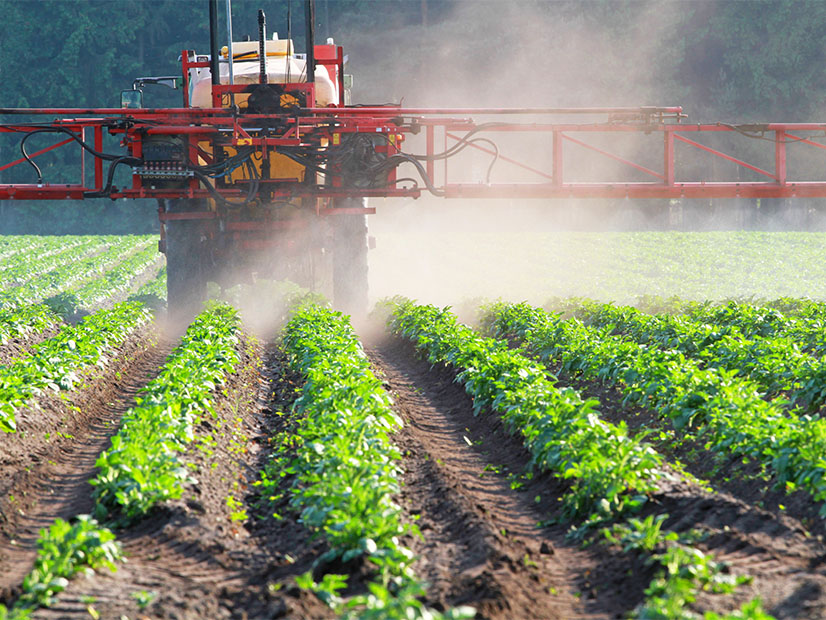Environmental groups have been urging the California Air Resources Board to include pesticide reduction strategies in its 2022 climate change scoping plan, and they now have the backing of CARB’s Environmental Justice Advisory Committee (EJAC).
The advisory committee voted on Nov. 9 to support a letter regarding pesticide use from Californians for Pesticide Reform and seven other groups.
As many as 59 organizations have signed onto letters to CARB or the governor this year asking that pesticide use be addressed in the 2022 scoping plan. The plan, which is updated every five years, is a roadmap for achieving the state’s greenhouse gas reduction goals.
And the groups made similar requests regarding pesticides during development of the 2017 scoping plan.
“Many of us have been calling for inclusion of pesticide reduction strategies in the state’s scoping plan since 2017, only to be told by CARB that there is insufficient research and/or that pesticides contribute only a negligible amount to GHG emissions when compared with other sources,” the groups said in their letter to EJAC.
The groups agreed that more research is needed on the subject of pesticides and greenhouse gases, and called for the state to fund studies on the topic.
But enough is known now to add pesticide reduction strategies to the scoping plan, they said. The groups have also asked CARB to add the Department of Pesticide Regulation to the list of 17 departments or agencies serving as collaborators on the scoping plan.
Pesticides’ Role Debated
EJAC was scheduled to hear an update from CARB staff on Nov. 16 regarding pesticides and the scoping plan, but the item was postponed. A CARB spokesperson did not respond to a request for comment on the letter the committee voted to support.
But CARB staff discussed pesticides during a July 20 scoping plan workshop focused on natural and working lands.
During the workshop, EJAC member Martha Dina Arguello asked how the impact of pesticides on greenhouse gas emissions would be addressed.
“I’m strongly concerned about excluding pesticides from the whole framing around the natural and working lands,” said Arguello, who is executive director of Physicians for Social Responsibility – Los Angeles.
Nicole Dolney, manager of CARB’s Emission Inventory and Economic Analysis Branch, said the agency is aware of two pesticides — methyl bromide and sulfuryl fluoride — that are greenhouse gases.
She said the use of methyl bromide is being phased out under the Montreal Protocol and emissions from the pesticide are “very small.” Sulfuryl fluoride is being tracked as part of the short-lived climate pollutants inventory, she added.
At least one study has found that use of sulfuryl fluoride is increasing as the pesticide replaces methyl bromide. The researchers, who describe sulfuryl fluoride as a potent greenhouse gas, found that the increase was mainly because of fumigation of buildings in North America. But postharvest treatment of crops also contributed, they said.
Matthew Botill, assistant chief of CARB’s Industrial Strategies Division, acknowledged the number of comments received on pesticides during the scoping plan process. Botill said pesticides weren’t directly included in modeling work discussed during the workshop.
“We are interested in looking at what those potential effects of pesticides are on greenhouse gas emissions,” Botill said.
GHG Contributions
In their letter to EJAC, the environmental groups outlined ways in which pesticides may contribute to greenhouse gas emissions.
The groups pointed to volatile organic compounds contained in pesticides, which react with sunlight and nitrogen oxides to form tropospheric ozone. Tropospheric, or ground-level ozone, is a greenhouse gas that is also harmful to health, according to the University Corporation for Atmospheric Research.
Soil fumigants, which account for about 20% of pesticides used in California, can increase nitrous oxide emissions, the groups said in their letter. In 2019, nitrous oxide accounted for about 7% of the nation’s greenhouse gas emissions from human activities, including agriculture, according to the U.S. Environmental Protection Agency.
In California, demographic data show “a pronounced racial disparity” in the amount of pesticide use in counties with the largest share of Latino residents, the letter said, with the greatest impact on the San Joaquin Valley.
In addition, the groups argue that organic farming naturally sequesters carbon and other GHGs to a greater extent than farming that uses chemicals.
“It is critical that the scoping plan include measures supporting rapid transition of chemical-reliant farming to organic farming that focuses on building soil and plant health,” the groups said.



